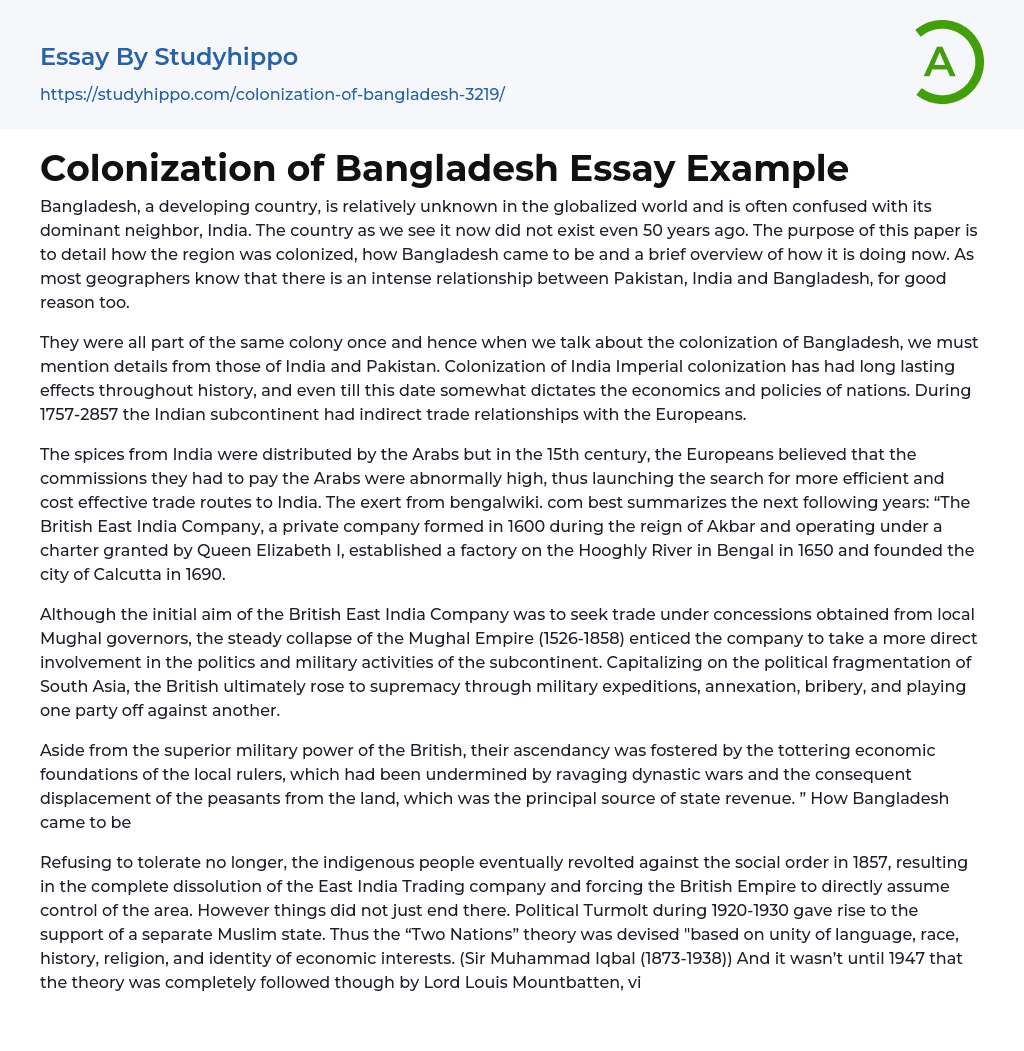Bangladesh, a developing country, is relatively unknown in the globalized world and is often confused with its dominant neighbor, India. The country as we see it now did not exist even 50 years ago. The purpose of this paper is to detail how the region was colonized, how Bangladesh came to be and a brief overview of how it is doing now. As most geographers know that there is an intense relationship between Pakistan, India and Bangladesh, for good reason too.
They were all part of the same colony once and hence when we talk about the colonization of Bangladesh, we must mention details from those of India and Pakistan. Colonization of India Imperial colonization has had long lasting effects throughout history, and even till this date somewhat dictates the economics and policies of nations. During 1757-2857 the Indian subcontinent had
...indirect trade relationships with the Europeans.
The spices from India were distributed by the Arabs but in the 15th century, the Europeans believed that the commissions they had to pay the Arabs were abnormally high, thus launching the search for more efficient and cost effective trade routes to India. The exert from bengalwiki. com best summarizes the next following years: “The British East India Company, a private company formed in 1600 during the reign of Akbar and operating under a charter granted by Queen Elizabeth I, established a factory on the Hooghly River in Bengal in 1650 and founded the city of Calcutta in 1690.
Although the initial aim of the British East India Company was to seek trade under concessions obtained from local Mughal governors, the steady collapse of the Mughal Empire (1526-1858) enticed the compan
to take a more direct involvement in the politics and military activities of the subcontinent. Capitalizing on the political fragmentation of South Asia, the British ultimately rose to supremacy through military expeditions, annexation, bribery, and playing one party off against another.
Aside from the superior military power of the British, their ascendancy was fostered by the tottering economic foundations of the local rulers, which had been undermined by ravaging dynastic wars and the consequent displacement of the peasants from the land, which was the principal source of state revenue. ” How Bangladesh came to be
Refusing to tolerate no longer, the indigenous people eventually revolted against the social order in 1857, resulting in the complete dissolution of the East India Trading company and forcing the British Empire to directly assume control of the area. However things did not just end there. Political Turmolt during 1920-1930 gave rise to the support of a separate Muslim state. Thus the “Two Nations” theory was devised "based on unity of language, race, history, religion, and identity of economic interests. (Sir Muhammad Iqbal (1873-1938)) And it wasn’t until 1947 that the theory was completely followed though by Lord Louis Mountbatten, viceroy of that region, and divided it into partitions of religious demographics thus giving birth to the Islamic Republic of Pakistan and Republic of India. Pakistan, however, had two segments to it. West Pakistan and East Pakistan, divided on the basis of language. But even then, West Pakistan insisted that Urdu be the dominant language and eventually invaded East Pakistan.
In 1971, with the help of the Indian Armed Forces, Bangladesh finally liberated itself from the oppression and tyranny of West Pakistan and
rose as a liberated nation on its own. Bangladesh in post-colonial times A theory created by Acemoglu, Robinson and Johnson states that “colonies that were set up as settlement colonies will experience greater levels of development after independence because settlement colonies have witnessed and experienced forms of government via their colonizers and are therefore structured to perform better than extractive colonies.
Extractive colonies on the other hand, were used by the colonizers solely for their resources and thus the extraction of their resources and the lack of any advanced government institutions and frameworks leads to them performing worse relative to settlement colonies, as defined in terms of income per capita. ” Since Pakistan, India and Bangladesh were all part of colonial India, it is logical to assume that these three countries will experience similar levels of development. I will attempt to deduce this using GNI per capita, GDP per apita and the HDI Index. It is clear from the data above that India has outpaced both Pakistan and Bangladesh in recent times leading me to believe that the proposed theory does not hold true for Bangladesh. This is probably because the British set up different types of colonies in different regions, causing dissimilarities in growth. Pakistan and Bangladesh has been virtually the same on the HDI index but Pakistan beats Bangladesh in both GNI and GDP per capita.
There are several major factors contributing to Bangladesh’s poor growth. Some of which are, but not restricted to, limited exports, poor living conditions, lack on investments and education, and corruption in the political system. However, even then I would say that the colonization has benefitted Bangladesh because the data
above shows that each of them have been roughly trending upwards since the country’s liberation (1971) and implies that it was lower pre-1971. Even though Bangladesh did not exist during the colonial times, it did exist as a part of colonial India.
Hence I believe that the indigenous people were inspired in the acts of governance from the East India Company and the British Empire.
Bibliography
- “Bengali Wiki – Bangladesh. ” bengaliwiki. com/page/Bangladesh. 2009. Web. 16 February 2012
- “Impacts of Colonization on India, Pakistan and Bangladesh by Emily de la Reguera and Jessi Waters. ” jessiwaters. blogspot. com/2011/07/impacts-of-colonization-on-india. html. 2011.
- Web. 160 February 2012 “Google Public Data Explorer - World Development Indicators and Global Development Finance. ” google. com/publicdata/directory. 2012. Web. 16 February 2012.




